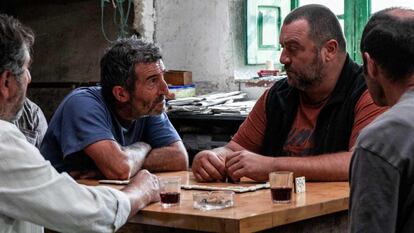Similarities between films and paintings: Seven examples of how cinema is inspired by art
El PAÍS chooses six paintings from Madrid’s Prado Museum and compares them with their film ‘version’

Let’s play a game, a hopscotch of antique painting and cinema. Viewing some paintings at the Prado Museum often calls to mind a film, and vice versa, because of the style, the title, the composition. Museum visitors can make their own associations. But it is undeniable that Caravaggio, for example, heavily influenced filmmakers like Victor Erice and Martin Scorsese (the latter has mentioned Caravaggio’s influence on his 1977 movie Mean Streets). The old masters’ paintings were the films of 500 years ago.
Here, in this game, we offer a list of Spanish paintings and films, plus director Wong Kar-wai’s In the Mood for Love, for its tenebrist-style photography and a final voice-over, which is a painting in its own right: “He remembers those years as if looking through the glass of a window covered with dust. The past is something we can remember but not touch. All that is remembered is blurred and vague.” So are many old oil paintings. Time is also a painter.
Still Life with Game Fowl, Vegetables and Fruit (1602) / The Hunt (1966)
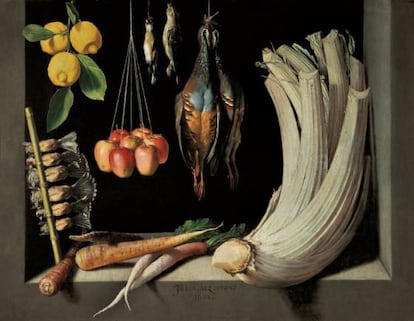
Presaging Caravaggio, partridges, birds, lemons, carrots, radishes and a thistle that seems to be freshly cut are placed in a dark cupboard with incredible realism. Juan Sánchez Cotán was a Carthusian monk, but there is nothing mystical in this canvas, only his incredible realism showing a still life with game.
Death is the main character of Carlos Saura’s film The Hunt, a classic of Spanish cinema. It involves settling scores between friends who fought on Francisco Franco’s side in the Civil War. What was supposed to be a day of hunting turns into a dark, gloomy night—like the background in Cotán’s still life—leading to carnage between them.
The Bacchanal of the Andrians (1523) / Viridiana (1961)

Titian was considered to be the best painter of his time. The Bacchanal of the Andrians depicts an orgy where gods, men and children gather to enjoy the pleasures of wine. Michelangelo’s influence can be seen in the piece, but, above all, it is an erotic celebration of life.
Luis Buñuel’s Viridiana is a unique work. Francisco Franco’s censors finally approved the filming of the movie with the fourth version of the script. They barely understood anything: The film includes the suggestion of a ménage à trois, beggars in a prodigious final coven, the disinherited and meek of the earth rebelling and a Dionysian dinner.
Duelo a garrotazos [Duel with Cudgels] (1820-1823) / The Beasts (2022)
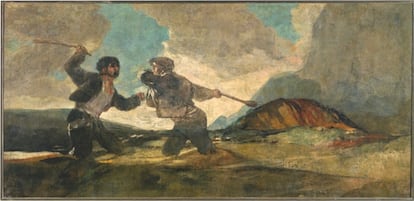
Duelo a garrotazos [Duel with Cudgels] is one of the 14 Black Paintings that decorated the Quinta del Sordo house on the outskirts of Madrid. Goya bought the residence and painted this work on the walls with oil. It has never had a precise explanation. It’s violence on violence, hatred of the other.
Someone coined the precise term for Rodrigo Sorogoyen’s film The Beasts: “Rural terrorism.” A French couple arrives in an isolated village in Galicia, Spain, to cultivate a vegetable garden and connect with nature. But the neighbors want to leave there with the money promised by a wind turbine company. There’s a confrontation between the outsiders (who fear for their lives) and those who feel they are the rightful owners.
David with the Head of Goliath (1600) / El Sur [The South] (1983)
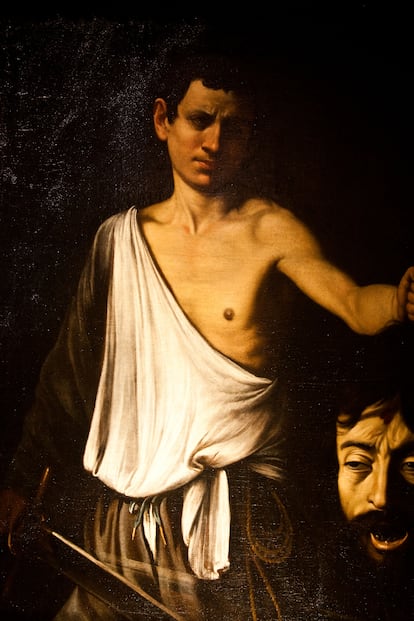
David with the Head of Goliath is the only Caravaggio painting in the Prado. No one knows how it got there. It is strange in every way. David ties up the hair of the giant Goliath, whom he has just killed, to take his head. This image does not appear in the Bible. It represents the Jews’ victory over the Philistines.
El sur [The South], by Víctor Erice, is a masterpiece. EL PAÍS film critic Ángel Fernández-Santos wrote thaT “its beauty is indescribable.” Carlos F. Heredero added that it’s the “beautiful struggle of light to shine against some fragments of life.” This light (Alcaine’s extraordinary photography), the chiaroscuro, which permeates the film, is Caravaggio’s legacy. It’s the story of a father repressed by [dictator] Francisco Franco and the daughter who wants to get to know him. A key scene in Erice’s new film Close Your Eyes (2023) takes place in the Prado museum’s cafeteria.
Doña Juana la Loca [Queen Juana the Mad] (1877) / Mad Love (2001)
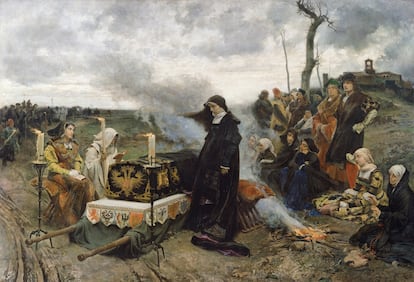
Doña Juana la Loca [Queen Juana the Mad] is Francisco Pradilla’s best painting, which he created at the age of 29. The work is reactionary, in the sense that it does not add anything novel (in France the avant-garde artists were seeking new methods). It represents the passion of Juana I of Castile (1479-1555) over an unrequited love (Philip the Handsome), madness, jealousy and necrophilia.
In Vicente Aranda’s film, actress Pilar López de Ayala plays Juana the Mad in one of Spanish cinema’s most extraordinary scenes: It is raining in the courtyard. She turns around with her arms open, throws off her red cloak and cries out, “My mother is dead!
-My mother is dead! My husband is cheating on me! My mother is dead! My husband is cheating on me!
The Abduction of Helen (1578-1579) / Take My Eyes (2003)
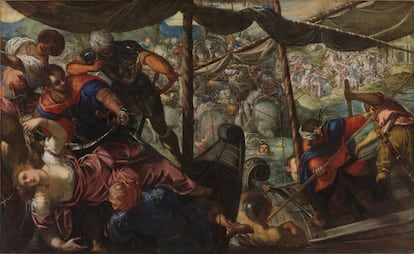
Tintoretto does not hide the brutality of the scene in The Abduction of Helen. She cries and pleads before her attackers. Her clothes are partly torn off and one breast is exposed. It looks like a rape. All around her, Turks and Christians are fighting to the death, over her.
It’s sexist male violence, explained from the perspectives of the victim and the aggressor. Explaining is very different from justifying. In Take My Eyes, Icíar Bollaín tries to enter that dark labyrinth without an exit, which is how a torturer thinks.
In the Mood for Love (2000) / Caravaggio (1571-1610)
There are many Caravaggio-like scenes in Wong Kar-wai’s superb film, which narrates extra-marital love affairs in 1962 Hong Kong; none are better than watching actress Maggie Cheung descend the stairs in search of food as the music of Japanese composer Shigeru Umebayashi plays. It’s tenebrism in motion.
Sign up for our weekly newsletter to get more English-language news coverage from EL PAÍS USA Edition
Tu suscripción se está usando en otro dispositivo
¿Quieres añadir otro usuario a tu suscripción?
Si continúas leyendo en este dispositivo, no se podrá leer en el otro.
FlechaTu suscripción se está usando en otro dispositivo y solo puedes acceder a EL PAÍS desde un dispositivo a la vez.
Si quieres compartir tu cuenta, cambia tu suscripción a la modalidad Premium, así podrás añadir otro usuario. Cada uno accederá con su propia cuenta de email, lo que os permitirá personalizar vuestra experiencia en EL PAÍS.
¿Tienes una suscripción de empresa? Accede aquí para contratar más cuentas.
En el caso de no saber quién está usando tu cuenta, te recomendamos cambiar tu contraseña aquí.
Si decides continuar compartiendo tu cuenta, este mensaje se mostrará en tu dispositivo y en el de la otra persona que está usando tu cuenta de forma indefinida, afectando a tu experiencia de lectura. Puedes consultar aquí los términos y condiciones de la suscripción digital.
More information
Archived In
Últimas noticias
Most viewed
- Sinaloa Cartel war is taking its toll on Los Chapitos
- Oona Chaplin: ‘I told James Cameron that I was living in a treehouse and starting a permaculture project with a friend’
- Reinhard Genzel, Nobel laureate in physics: ‘One-minute videos will never give you the truth’
- Why the price of coffee has skyrocketed: from Brazilian plantations to specialty coffee houses
- Silver prices are going crazy: This is what’s fueling the rally

